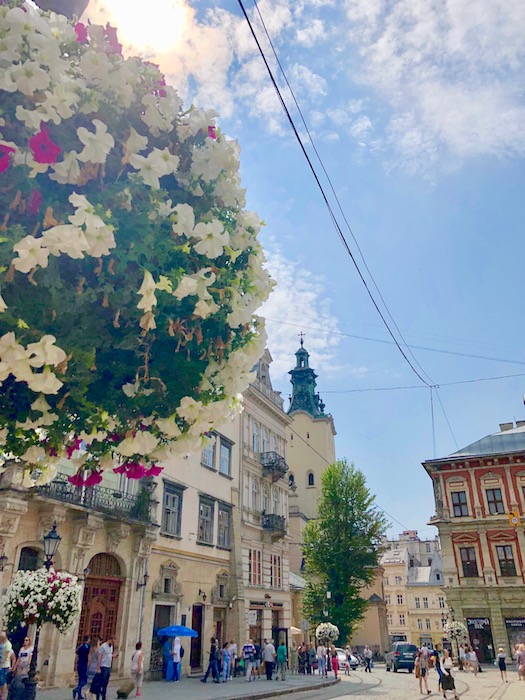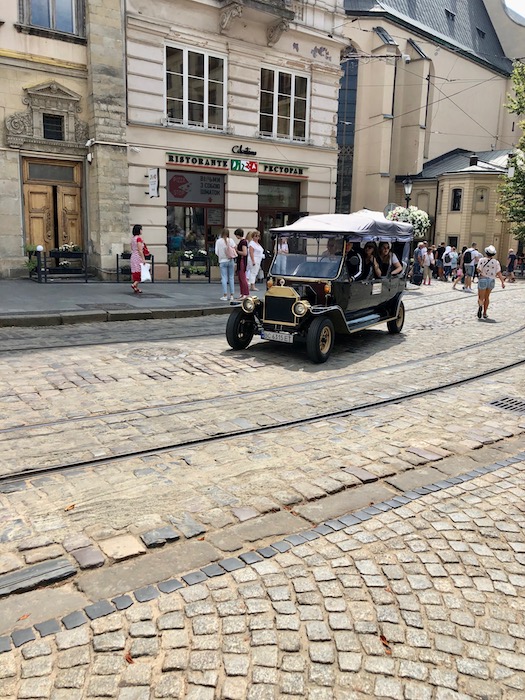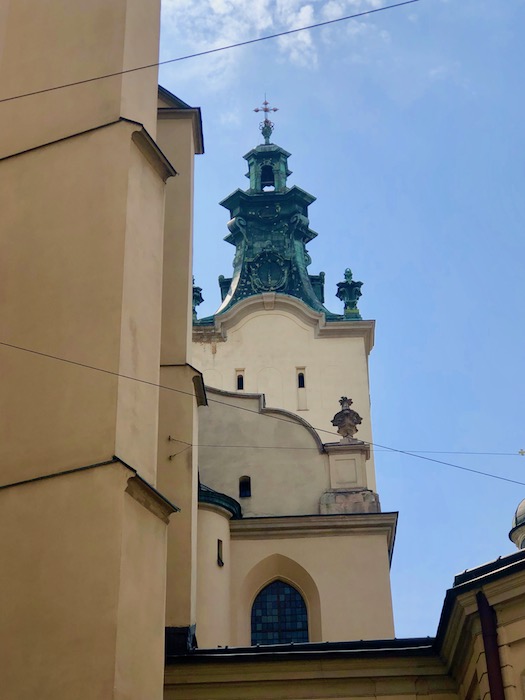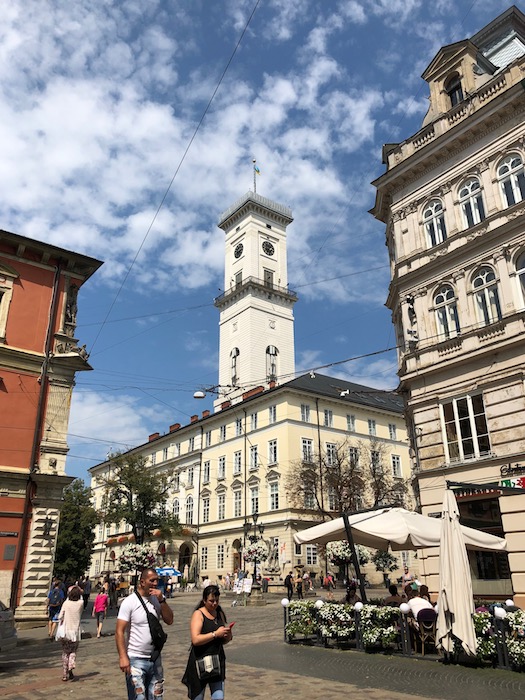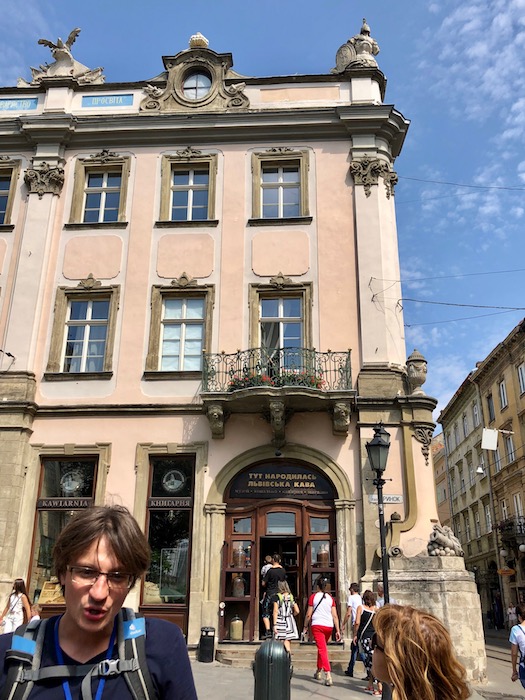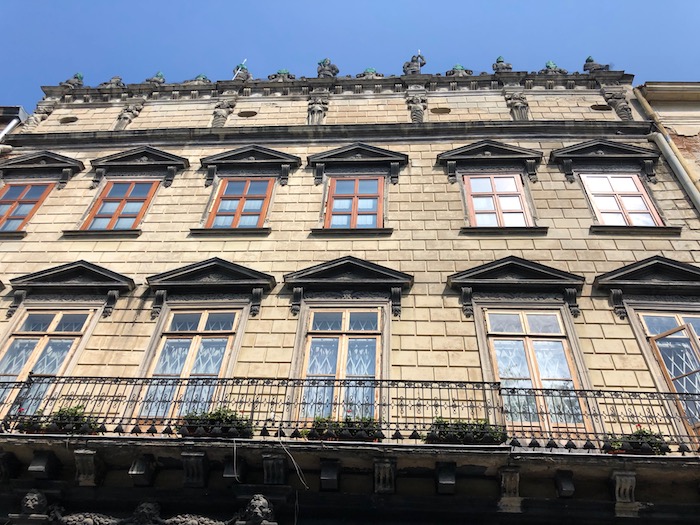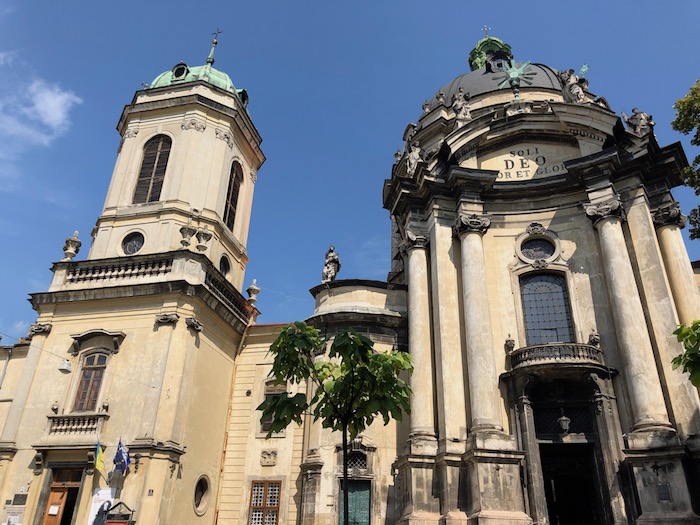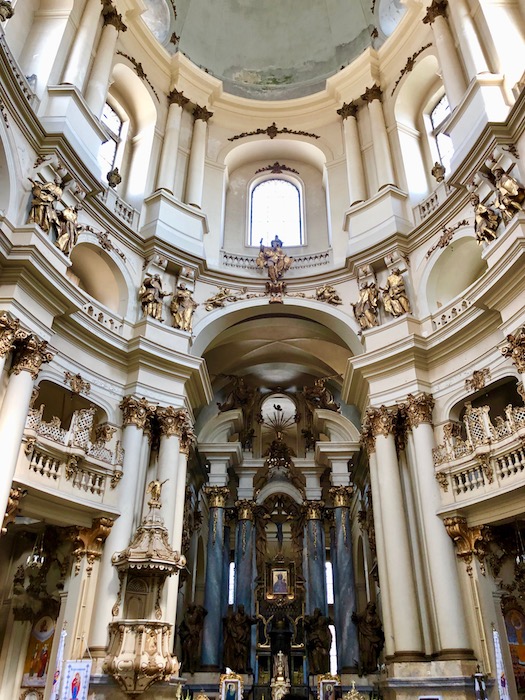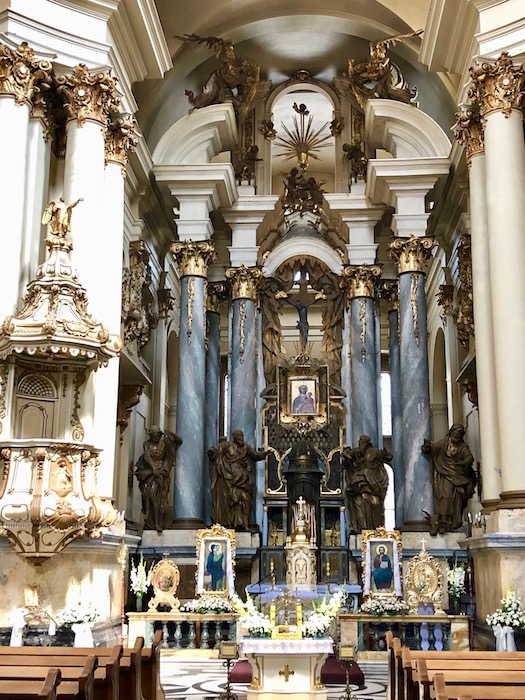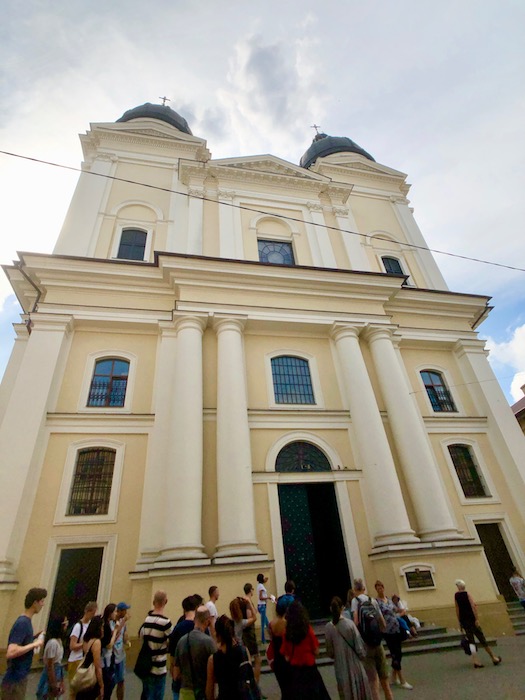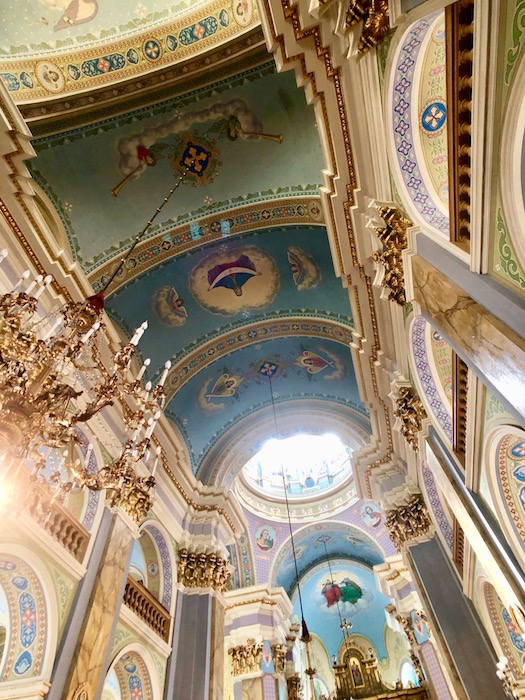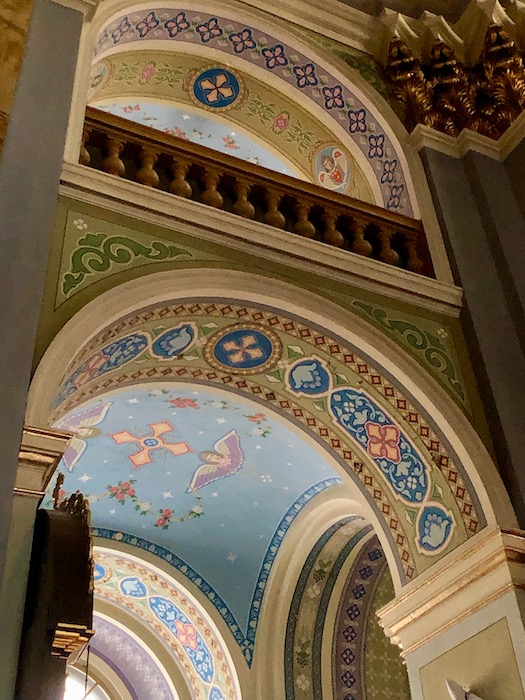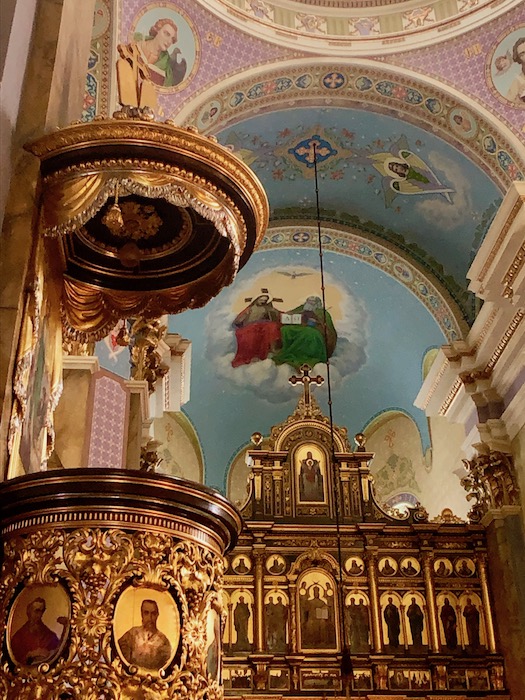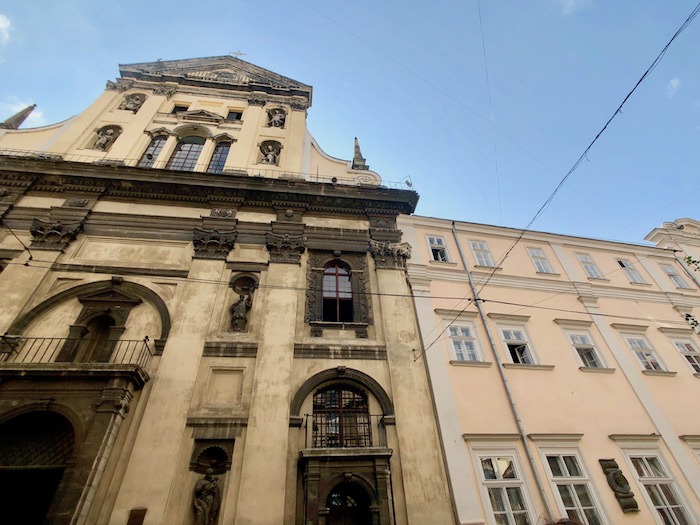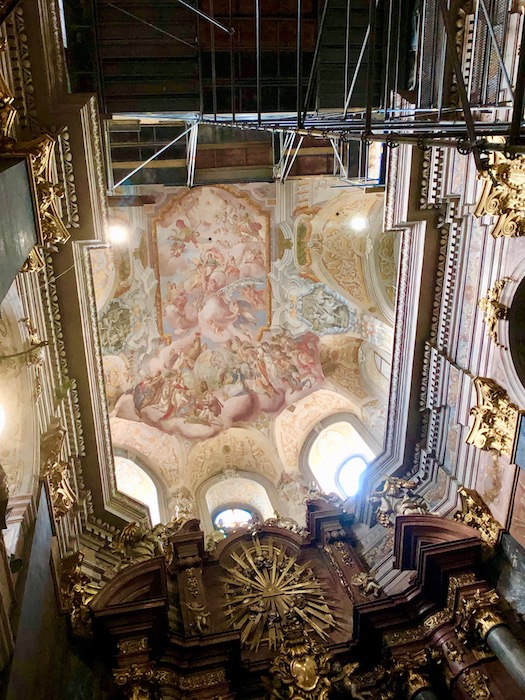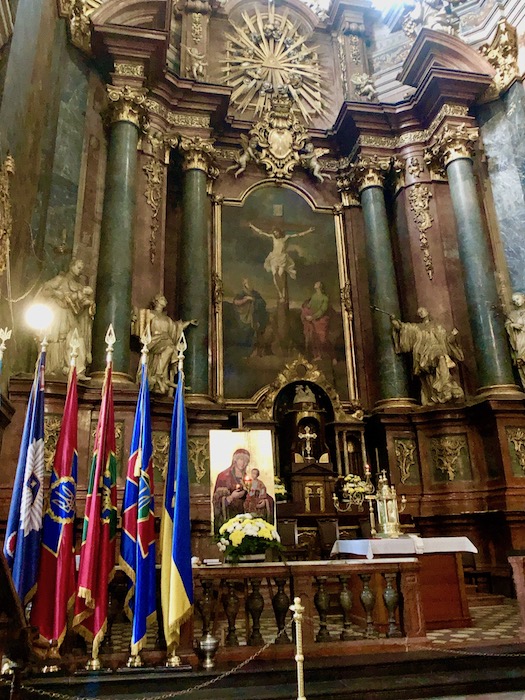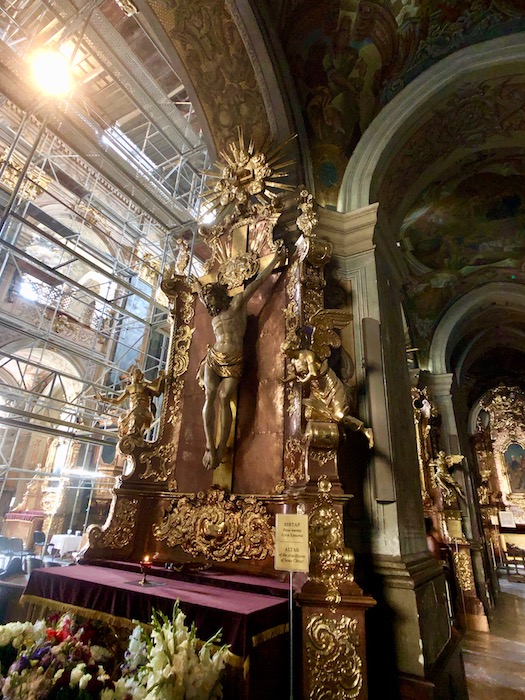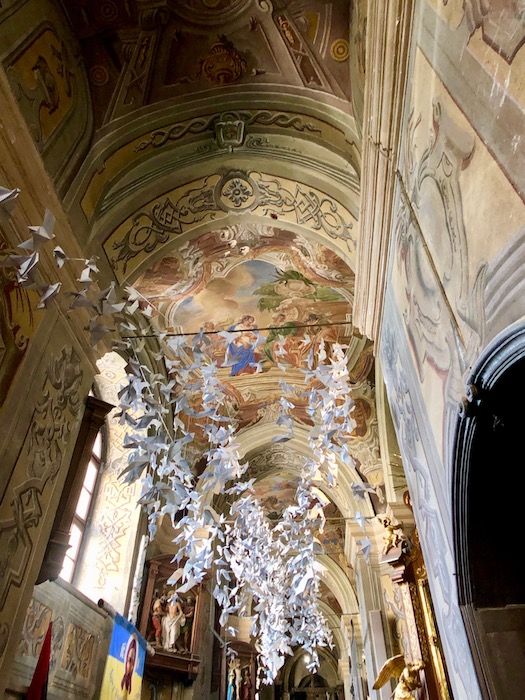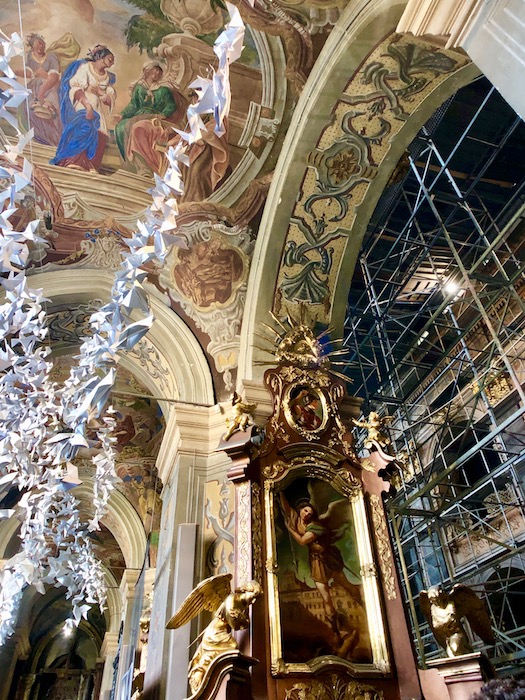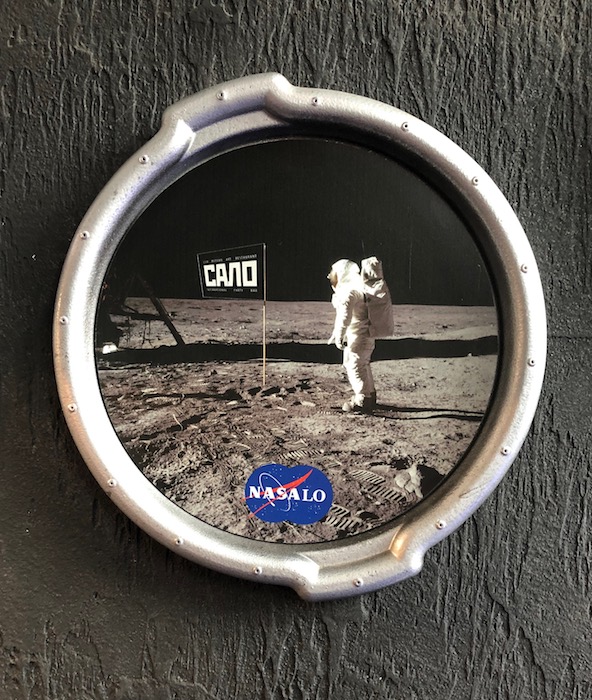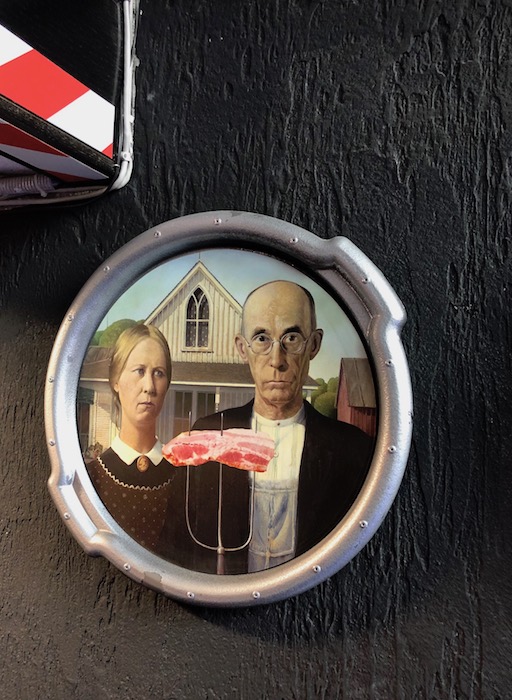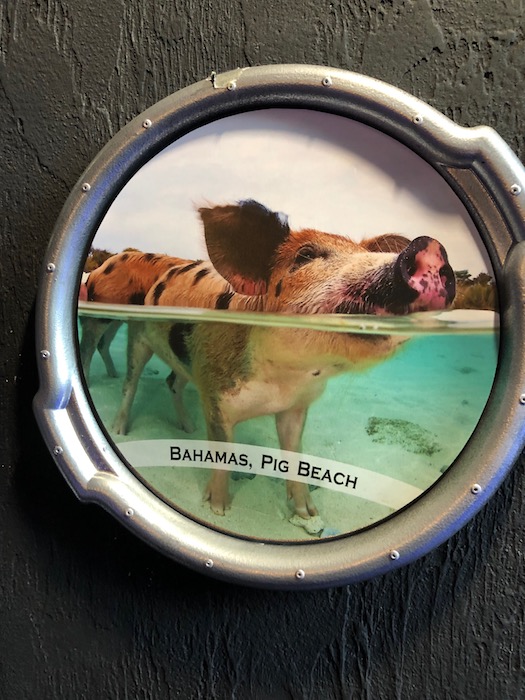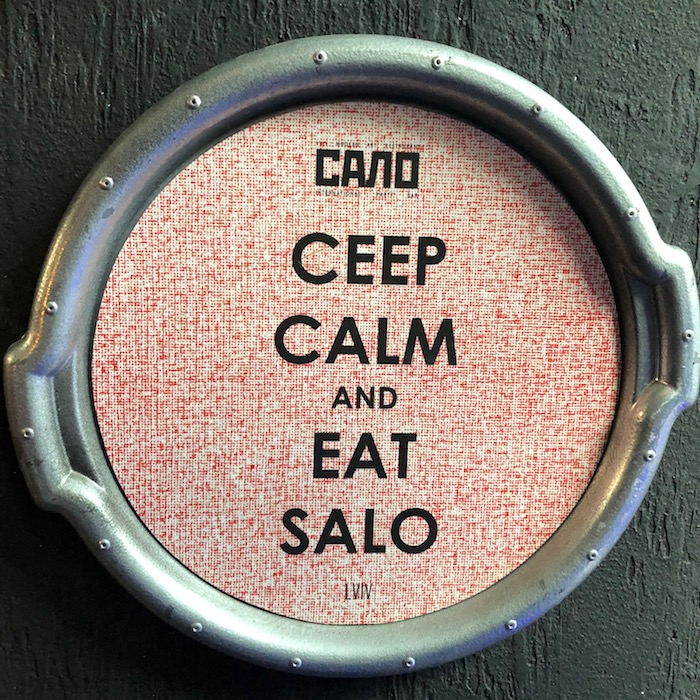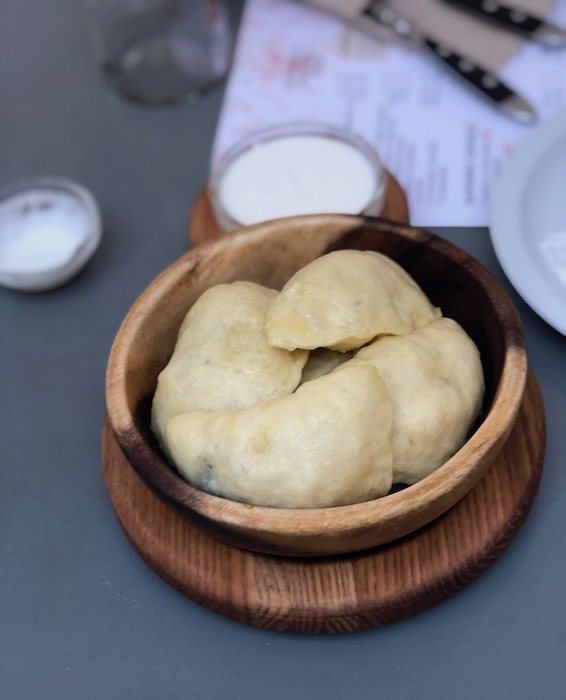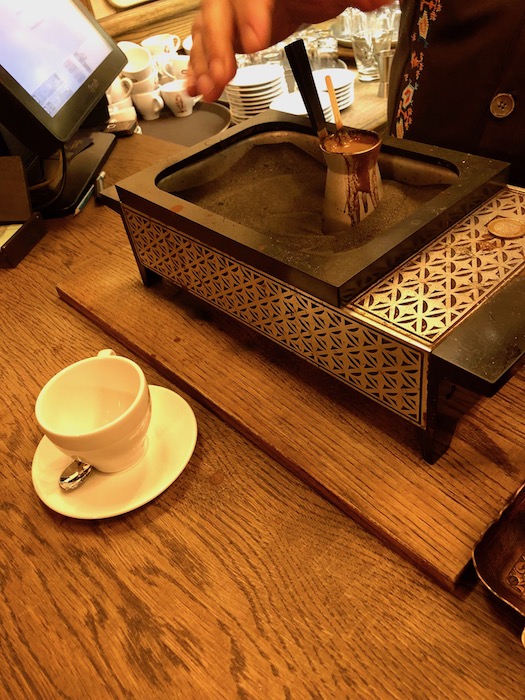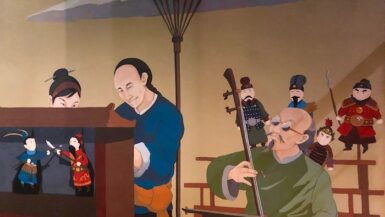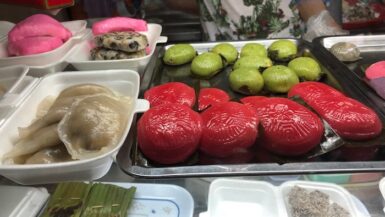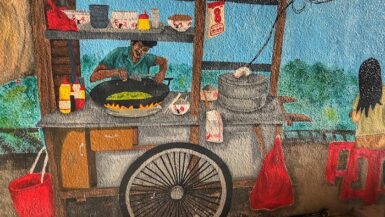July 30, 2019
I started off my afternoon with a walk around the streets in the immediate area of my apartment to familiarize myself with landmarks close by so I can find my way back. There’s a very popular rib restaurant on the corner, which is in my navigation app, so I should be able to find my way home.
My first impression of Lviv old town, particularly Market Square, is that it is cute.
So cute, couples like to have their pictures taken in the square.

My new favorite way to be introduced to a new city is to take a free walking tour. You go on the tour and then if you pay the tour guide what you think it was worth. Sometimes the tours are so-so and sometimes they are great. The free tour I took with Walkative this afternoon fell in the so-so+ category. While the guide, Andry had a lot of knowledge, most of the time you couldn’t hear him and by the time you caught up with him, he was partway through his description of wherever he’d stopped. The group was big, so I get not being able to wait for everyone, but it was a little annoying.
We started off at Lviv’s town hall – the door flanked by lions. Lviv, like so many other cities I’ve been in, is the “City of Lions.” I believe that any city named after a king or the progeny of a king may associate itself with the lion.
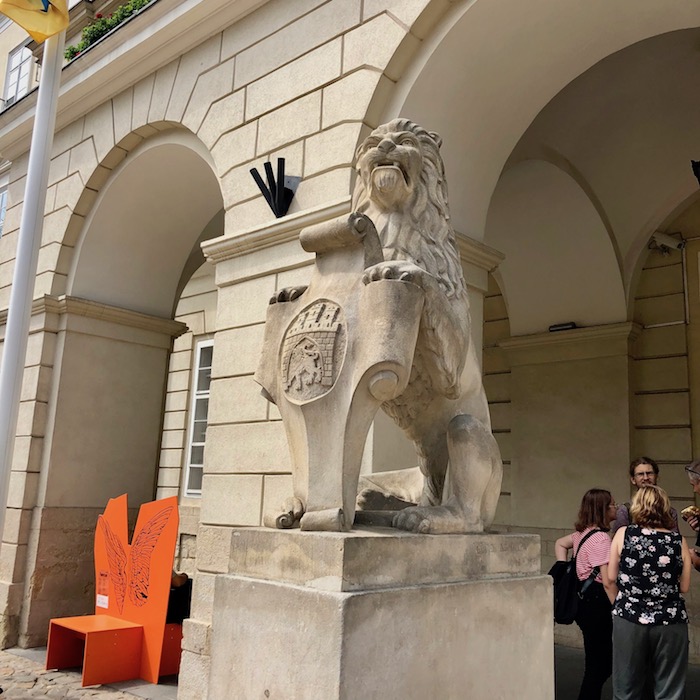
Andry showed us some of the homes near the square that belonged to wealthy traders and noblemen. If you want to know if the person was wealthy – count the number of windows they have. Any building with over three windows was taxed higher. The more windows you had, the more you wanted to flaunt your wealth.
The balcony in the second photograph above was notable as it was where Ukraine’s independence was proclaimed in 1941 – the independence lasted 1 ½ days – yes, days. They would not gain independence again until 1991.
An independent merchant established the first post office in Lviv in 1629. He thought it would be a great way to gain his fortune. He wanted to bring his business luck, so he commissioned an artist to sculpt dolphins to be placed on the face of the building. Apparently, dolphins bring you luck. Unfortunately, the merchant selected an artist who had never seen a dolphin. His versions ended up not being so lucky (they were downright evil-looking) because the government opened their own post office and the merchant’s independent office failed.
I’ve gotten used to Ukrainian churches being lavishly decorated inside, so I was a bit surprised at the austereness of the Dominican Cathedral’s baroque architecture. Although it had a serene beauty, the main decoration was the altarpiece. The sculptures making up the altar were actually made of wood and then covered in bronze and/or gold leaf. The remainder of the interior was very white and very cold. I’m not sure I’d like to go to mass in the cathedral in the winter. I can only imagine how cold it gets.
As we walked through the streets of the old town, Andry pointed out a building that used to be an Armenian monastery. It’s currently used as a modern art museum. He pointed out the “Stairway to Heaven” installation on the roof. I’m not much into modern art, so I think I’ll skip it – although the ladder’s placement is funny.
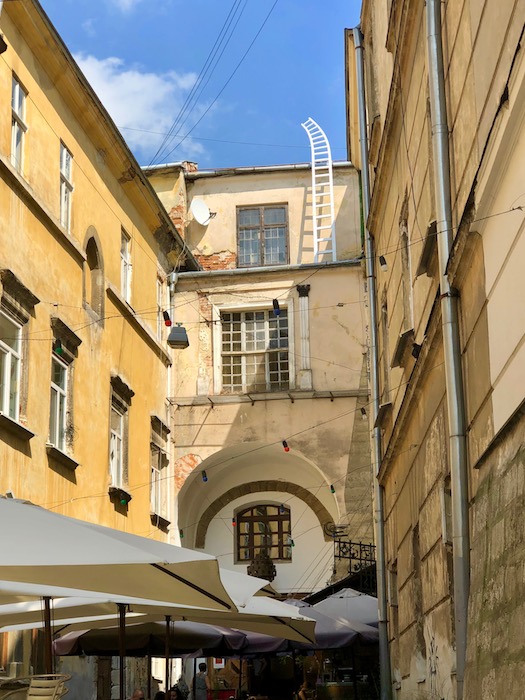
We stopped by a bar named Kerosene, which pays homage to the two men who discovered kerosene while trying to extract alcohol out of oil. It’s amazing what can be discovered when looking for something else.

The Ukrainian cathedral was more in sync with what I’ve become used to in churches in Ukraine. The pastel colors and detailed artwork were gorgeous. Even with the excessive use of gold leaf, there’s something soothing about the interiors of Ukrainian churches.
The final church I entered with the group was built by the Jesuits when they built the first university in the area in 1661. In contrast with the last church, this one is very dark and heavily gilded. It is undergoing extensive renovation at the moment. The church is dedicated to soldiers and the military. There is even an ad hoc museum dedicated to the casualties of the current conflict – above photographs and mementos of those who have been lost are hundreds of origami doves made by children signifying the hope the conflict will end soon.
At about this point, I had tired of trying to catch up with the group, so I headed back to Market Square to meet my guide for the food tour I had scheduled for the evening. Shortly, I was met by Uliana, a lovely woman who works in Ukraine for Lviv Buddy during most of the year, but spends her winters in SE Asia during the winter – smart woman to get out of the cold.
The first stop on our food tour was Cano, a bar/restaurant specializing in everything salo. Salo is a traditional food that consists of pork fat. Cano’s interior decorations proclaim the joys of salo, they make sculptures out of salo (use your imagination – my photo didn’t turn out), and they serve salo more ways than you ever imagined pork fat could be served.
Our appetizer plate had salo 15 different ways. In homage to Forrest Gump (they use one of his catchphrases on the front of their menu), you can have salo frozen, fried, pickled, cured, with parsley, with dill, spicy, … I’ve got to be honest, this wasn’t my favorite snack. I’m usually the one cutting the fat off my meat, not eating it. I will admit that the salo with dill was pretty good, but I wasn’t a fan of the rest (the pickles were good). Uliana explained that people usually eat it as a snack while drinking vodka – maybe that was what was missing.
As we walked to our next destination, buildings were looking familiar. We stopped at the restaurant, Gwara, and sat down. As I looked around, I figured out why it looked familiar. We were sitting at the restaurant right next to my apartment. Good to know the restaurant just downstairs is a good one.
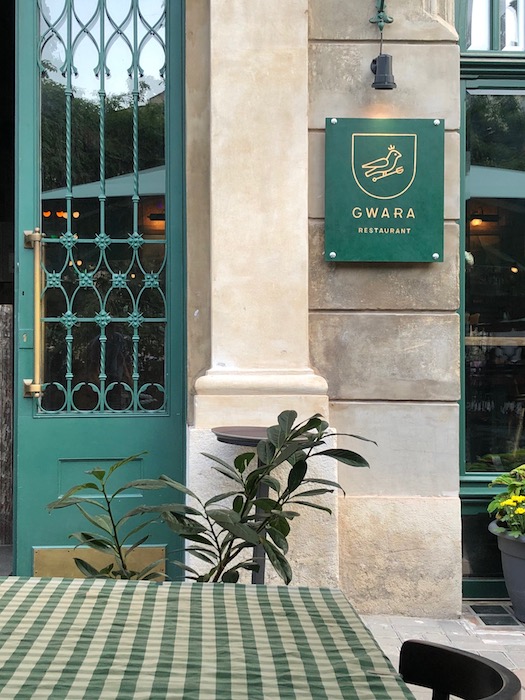
We were here to taste borsch. Uliana said that she thinks Gwara’s borsch is one of the better ones. Using veal as the meat for the broth gave the borsch a full-bodied taste. The soup was served with bread, sour cream, and a cup of garlicky beans. Adding the beans to the soup (which is what you’re supposed to do) definitely added to the flavor profile. I’m not sure that it beats Svetlana’s borsch, but it was really, really good.
Varenyky was the next dish on the food tour menu. We walked back towards Market Square and stopped at a restaurant just across from the soldier’s church. I got a picture of the name, but I’m not sure how to translate it into English. We ordered a plate of traditional potato and mushroom varenyky (with fried salo cracklings on top) and a plate of dessert varenyky with cherries. Of course, both types were eaten with sour cream and were very good.
Our last stop for the evening, just as it was getting dark was for coffee. There’s a big coffee/café culture in Lviv. Traditionally, however, coffee wasn’t served until late because if you offer someone coffee at your home that means the evening is over and you want them to leave. Make sure you remember that the next time you invite a Ukrainian to your home or party.
Anyway, Uliana took me to a cute little coffee place where they serve Turkish coffee and prepare it traditionally, using heated sand. The barista mixed dark coffee powder with water in a little copper carafe, then heated the thick mixture by swirling the carafe around in 200-degree sand – it starts to bubble pretty quickly. The coffee looked very dark and strong. I opted for an Americano and added lots of milk.
As we started to drink our coffee and chat, the skies opened up and it began to pour. It rained so hard that we had to move indoors because water was dripping from the awnings on our table. Not to worry, rainstorms don’t last too long in Lviv. Word to the wise – always carry an umbrella while in Lviv – storms whip in and out quickly.
Before saying goodnight after a delightful and educational food tour, Uliana showed me where the neighborhood minimart was located. During my earlier walks, I wasn’t able to find a supermarket to get a few things for the apartment. That’s because there isn’t one anywhere nearby. The closest one is at least a 30-minute walk. I guess that’s something I should have asked when booking the apartment. Live and learn.




